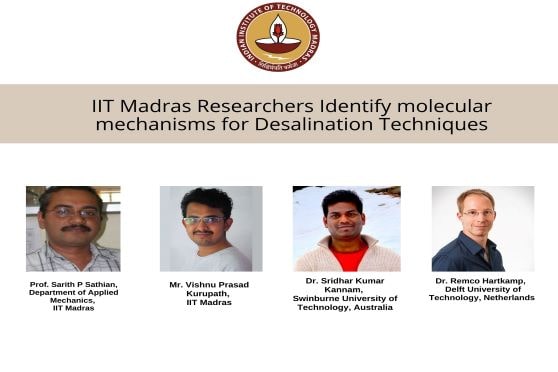IIT Madras researchers’ new study might just make seawater drinkable


The Indian Institute of Technology (IIT) Madras Researchers have identified the possible molecular mechanisms in water flow through a new nanopore geometry for desalination techniques to convert seawater to drinking water.
The results of the study, which involved Swinburne University of Technology, Australia, and The Netherlands-based Delft University of Technology, are useful in the design of novel RO (reverse osmosis) systems that utilise carbon nanotubes-based membranes.
The research team took inspiration from nature, specifically biological systems for making efficient desalination membranes.
The study was a sponsored project granted to IIT Madras by the Department of Science and Technology (DST), Government of India, as part of its Water Technology Initiative (WTI).
As per a report of NITI Aayog, 40% of the Indian population will not have access to drinking water by the year 2030, and 21 major Indian cities, including Chennai and New Delhi, are at risk of running out of groundwater, which will impact around 100 million people. Scientific communities worldwide are looking out for ways how saline water in seas and oceans can be converted into freshwater for household and industrial use.
As India has a long coastline of around 7,000 km, desalinating seawater has been considered a solution to solve the country’s water woes. Though various desalination technologies exist in the market today, the high energy expenditure by these technologies restricts their widespread use.
The research was led at IIT Madras by Sarith P Sathian, Department of Applied Mechanics, IIT Madras, and the team has been working on nanoscale water transport through carbon nanotubes (CNTs) and graphene nanopores for developing better desalination membranes.
The team included Vishnu Prasad Kurupath from IIT Madras, Sridhar Kumar Kannam from Swinburne University of Technology, Australia, and Remco Hartkamp, Delft University of Technology, The Netherlands.
The findings of this study were published in the reputed peer-reviewed journal Desalination.
The practical applications of this research over the long-term include:
Although studies have shown that graphitic carbon materials show larger water permeation capability than the conventional RO membranes, their tube-like structures suffer from a reduction in permeation rates due to the hydrodynamic resistance at their entrance. To solve this issue, the research team took inspiration from nature, specifically biological systems for making efficient desalination membranes.
Sathian added, “Our study has opened up the inside view of water and ion permeation through nanoporous CNTs. They reveal the mechanisms responsible for the enhanced water permeation inside hourglass-shaped nanopores. It is hence possible that the same mechanisms be reproduced in a different system of nanopores which can provide a higher desalination efficiency. Secondly, ion rejection of the membrane is a crucial aspect when it comes to desalination through such nanoporous membranes. From our study, we find that the ion rejection is chiefly dependent on the CNT sizes. Hence, it could be possible to conceive a nanopore geometry with a very high permeation capacity without compromising the ion rejection.”